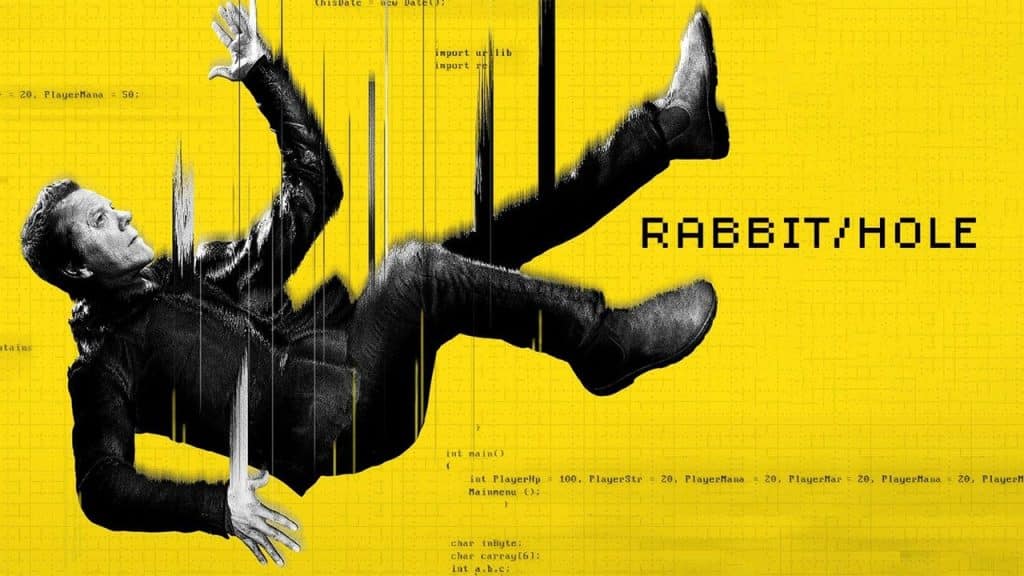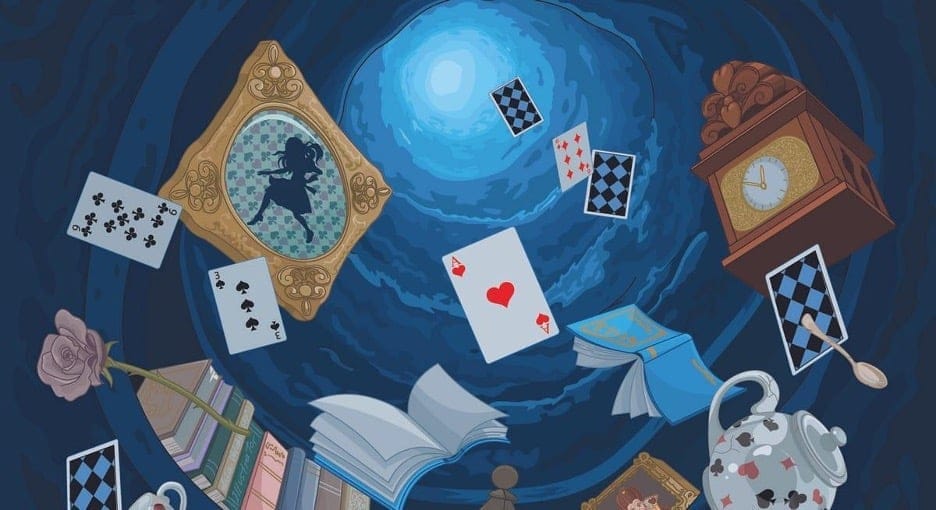
During halftime of Super Bowl LVII (57 for those not well-versed in Roman numerals), viewers were treated to a commercial in which giant anthropomorphic rabbits kidnapped people and threw them down a rabbit hole lined with TVs. No, this wasn’t an ad warning the public about rabbit-perpetrated abductions. It was part of a brand-new marketing campaign by Tubi, an ad-supported video-on-demand service owned by the Fox Corporation, which was urging viewers to “find rabbit holes you didn’t even know you were looking for.” Tubi’s allusion to Alice’s entrance to Wonderland was just the latest example of how the term “down the rabbit hole” continues to permeate more than 150 years after Lewis Carroll originally put pen to paper. In fact, Tubi’s rabbit holes show a recent shift in how the concept is viewed in pop culture.
Alice’s Adventures in Wonderland kicks off, of course, with Alice following the rushing White Rabbit down a rabbit hole into Wonderland. This portal to a world of whimsy and strangeness eventually took on a metaphorical meaning. The current operational definition, per the Oxford English Dictionary, is that a rabbit hole is a “bizarre, confusing, nonsensical situation or environment, typically one from which it is difficult to extricate oneself.” The negative, foreboding connotations in this definition can be seen in how “rabbit hole” was used in such diverse media as The Matrix, former Playboy Bunny Holly Madison’s memoir, Down the Rabbit Hole: Curious Adventures and Cautionary Tales of a Former Playboy Bunny, and, most recently, in the Paramount+ spy thriller series, Rabbit/Hole. As used in these examples, going down a rabbit hole has come to mean entering into a labyrinthian world with danger lurking behind every unknowable corner.

Of course, everyone knows what someone means when they say they went “down a YouTube rabbit hole” last night. Pulitzer Prize winner Kathryn Schulz, writing for The New Yorker in 2015, explored how the rabbit hole in Alice in Wonderland had come to signify extreme distraction, specifically in respect to internet usage. Schulz, in wondering why rabbit hole has become so pervasive in public consciousness compared to elements in other fictional worlds, makes an important observation. “As a metaphor for our online behavior…the rabbit hole has an advantage,” she writes, “it conveys a sense of time spent in transit.” There is a further connection to Lewis Carroll’s world in that the digital rabbit hole also seems to transcend time and space. Often, we watch YouTube videos or read Wikipedia articles for what seems to be a short time, only to look up at the clock and find that what seemed like a walk around the block was actually a transcontinental flight. An internet rabbit hole may have even caused one to be late for a very important date from time to time.
But what about this idea of transit? In Alice in Wonderland, Alice travels through the rabbit hole on her way to Wonderland. She doesn’t spend time exploring every nook and cranny of the subterranean burrow. “The modern rabbit hole,” writes Schulz, “unlike the original, isn’t a means to an end. It’s an end in itself.” Remember those TVs lining the dirt in the Tubi ad? They weren’t just for entertainment while traveling to a wondrous, surreal destination. The rabbit hole is the destination. The journey, the experience of endless exploration, entertainment, and enlightenment is the goal. The wonder and magic of Wonderland can now be found in the trip through the rabbit hole, the permanence of a fixed point replaced by the emotional, intellectual, and sensory fulfillment of the itinerant digital traveler.

The current usage of going down a rabbit hole also promises individualization, that the experience is fully tailored to the individual. Indeed, Nicole Parlapiano, Tubi’s Chief Marketing Officer, stressed this point when speaking in reference to their Super Bowl ad campaign, saying the streamer has a “deep and diverse content library that allows people to dive into their own personal content journey…that might just lead them down the perfect rabbit hole for them.” Now, you’re not going down a rabbit hole, but your rabbit hole. One that conversely promises both discovery and familiarity. Jim Rutenberg, a writer at large for The New York Times, recently alluded to Alice in Wonderland in a piece titled “How Fox Chased Its Audience Down the Rabbit Hole.” In it, he discusses how Rupert Murdoch and Fox News created a personalized rabbit hole for their viewers, one that reflected the world they wanted to see. Of course, this has had dangerous political consequences but Rutenberg’s usage of rabbit hole shows the continued power that the term has with the public consciousness. Additionally, it is yet another example of rabbit hole being used to refer to a set of experiences and events rather than as a means of transportation.
It’s clear that the usage of rabbit hole has transformed from a conduit to a destination, but Tubi’s commercials also herald a shift in the way in which a rabbit hole is viewed. As stated earlier in this article, the term rabbit hole has commonly been used to imply something negative. Going down a digital rabbit hole often implies a loss of something - a loss of focus, a loss of sleep, a loss of time which could have otherwise been used in the pursuit of something productive. Yet the Tubi spot promises viewers that going down their rabbit hole will result in a sublime experience in which all their entertainment desires will be satiated. While one can be skeptical of Tubi’s assertions, there is a kernel of truth in their promise. Rabbit holes can be enlightening and entertaining, an expression of someone exploring their individuality. Going down a YouTube or Wikipedia rabbit hole often takes place within the context of someone achieving fulfillment through researching their interests. Going down a streaming rabbit hole can introduce viewers to content that will entertain, thrill, and comfort. Though certain particulars have changed over time, the modern usage of rabbit hole, promising enlightenment and happiness, is far closer to Lewis Carroll’s original meaning, invoking the sense that like Alice, we can all discover our own Wonderland.

An itinerant storyteller, John Drain attended the University of Edinburgh before studying film at DePaul University in Chicago and later earned an MFA in Screenwriting from the American Film Institute Conservatory. John focuses on writing mysteries and thrillers featuring characters who are thrown into the deep end of the pool and struggle to just keep their heads above water. His work has been recognized by the Academy Nicholls Fellowship, the Austin Film Festival, ScreenCraft, Cinestory, and the Montreal Independent Film Festival. In a previous life, John created and produced theme park attractions across the globe for a wide variety of audiences. John keeps busy in his spare time with three Dungeons and Dragons campaigns and a seemingly never-ending stack of medieval history books.